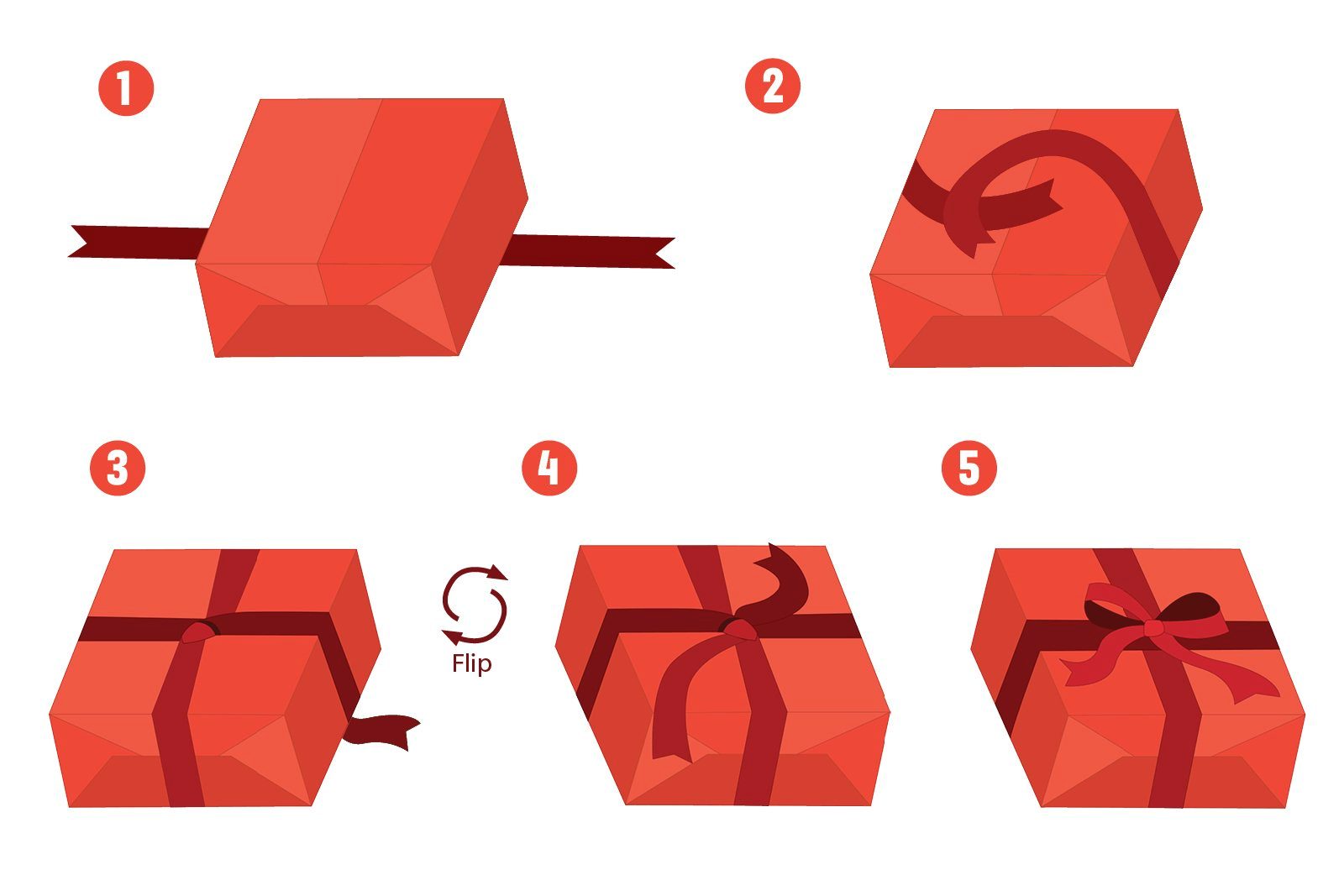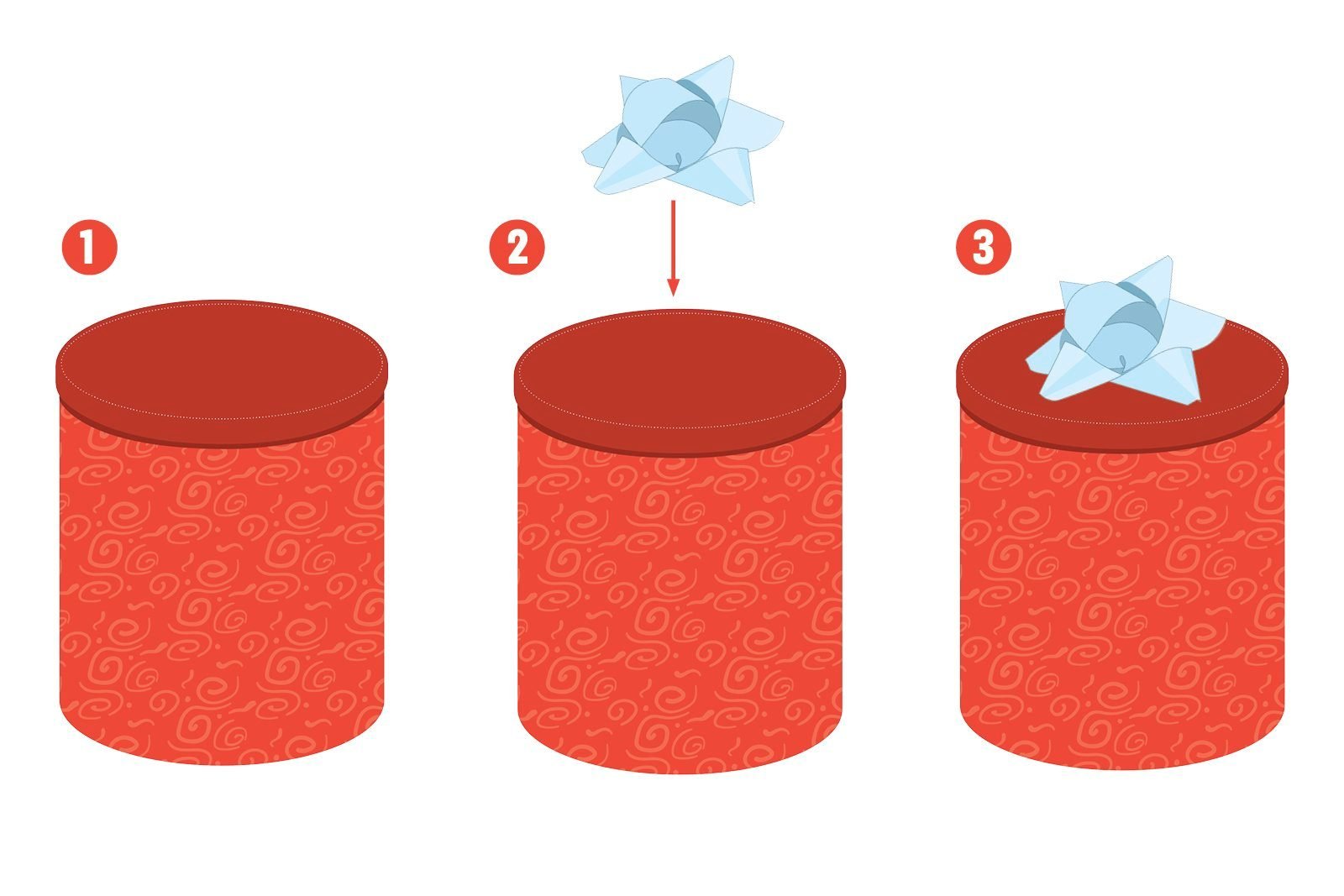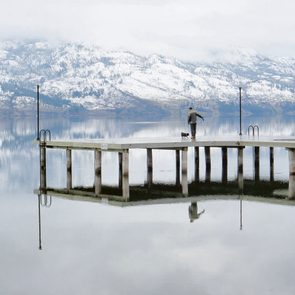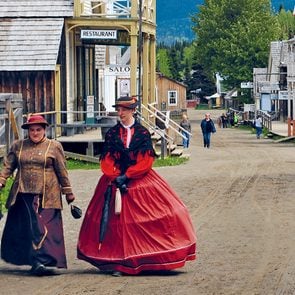A cozy fire is an essential part of the holidays (where else would the chestnuts roast in “The Christmas Song”?), but for all their festive ambiance, fireplaces can be fussy things. There’s the splitting of wood to think of, not to mention all of that ash and soot to sweep up (or at the very least, a hefty gas bill at the end of the holiday season).
That’s where virtual fireplaces come in. Simply press play on your nearest tablet, TV or heck, even your phone, and you can instantly bask in glow of roaring fire. It’s the perfect solution for any high rise condo or otherwise hearth-less home, and cranks up the festive flair with the click of a button.
The Origins of the Virtual Fireplace
Although it may seem like a modern-day innovation, the very first virtual fireplace dates back to 1966. Channel 11 (WPIX) in New York City wanted to produce a special Christmas program for viewers, so they went to the mayor’s home and filmed the fiercely crackling fireplace. A mere 17-seconds of footage was looped into three hours of classic TV that debuted on December 24, 1966, as “The Yule Log.” (If you’re feeling nostalgic, you can still enjoy this cinematic masterpiece on YouTube.)
The Yule Log inspired many imitations over the years, but the virtual fireplace really took off when streaming services arrived on the scene, allowing fans to have 24-hour access to these roaring delights. With so many virtual fireplaces available, we’ve rounded up five of the very best to make your holiday a little brighter.
Fireplace For Your Home on Netflix Canada
If you have a Netflix Canada subscription, then you have several glowing options. The original Fireplace For Your Home has three episodes—one fireplace set to holiday tunes, one a simple crackling hearth and a third accompanied by classical music. Then you have the Fireplace For Your Home: Classic Edition which features a truly roaring fire that provides the perfect white noise while you work (in fact, it provided much of the soundtrack to the writing of this very story). For the truly style-savvy, Netflix also offers the Birchwood Edition, which trades in standard firewood for chic black-and-white birch logs. All episodes are in 4K and one hour long. (Check out the best Christmas movies on Netflix right now.)
The Yule Log on CTV
Unlike most of the virtual fireplaces on our list, the one-hour Yule Log from CTV has an actual beginning: a man reaches into a darkened fireplace to light the kindling, which gradually (and oh-so satisfyingly) takes off into a blazing yule. Fans of the Birchwood Edition on Netflix may take issue with the logs here, which appear to be the leftovers from a weekend DIY project. On the upside, it’s free—and full of cheer!
Fire Log on Shaw TV
Do you like your fireplace with a side of mystery? The charming Shaw Fire Log (Shaw Channel 298 or the BlueCurve TV app) has been a staple since the 1980s, but inquiring minds want to know the identity of the man tending the crackling fire. All Shaw will reveal about the poker-wielding figure is that he’s got a penchant for flannel and smells of wood smoke. Follow every crackle from this fire log (and more from the man in flannel) on a designated Twitter account.
Fireplace on Prime Video
Amazon Prime subscribers who have opted into the Stingray All Good Vibes bundle can transport fireplaces from across Canada into their living rooms this holiday. Choose from a dozen different vignettes, including a charming stone fireplace from the Laurentians, and a blazing hearth from Banff—with accompanying carols.
The Best Burning Fireplace on YouTube
YouTube is full of virtual fireplace videos, but this one is (as its title claims) the best. It’s in super-sharp 4K definition, runs for 10 hours and is totally free. The blackened brick backdrop gives you the nostalgic, old-timey vibes you’re craving on chilly December days, and pairs beautifully with coffee and Baileys.
Next, check out the best places to spend Christmas in Canada.

Walk into any pharmacy and you’ll see rows of moisturizers, all promising something different. Figuring out which ones could work for you can seem overwhelming, especially because, according to the Harvard Medical School, “moisturizer” is more of a marketing label than a scientific one.
Generally speaking, though, it’s an umbrella term for products with three categories of ingredients: emollients, humectants and occlusives. Put simply, “a moisturizer hydrates skin and improves its texture,” says Dr. Lisa Kellett, a dermatologist in Toronto.
How Moisturizers Work
Our skin consists of three layers: the hypodermis (the deepest, made up of fat, nerves and blood vessels), the dermis (the in-between layer, which includes nerves, blood vessels, hair follicles and sweat glands) and the epidermis (the outermost layer of skin).
Throughout the day, water from the dermis evaporates through the epidermis and into the air via a process called transepidermal water loss (TEWL). On average, a person loses between 300 and 400 millilitres of water per day through their skin. Though this is a natural bodily process, environmental factors and medical conditions like eczema can contribute to a higher rate of TEWL and lead to dry, scaly or cracked skin.
This is where moisturizers come in. Emollients, like butters and oils, smooth the skin by filling spaces between dead cells, while humectant ingredients (including salicylic acid) work by pulling water from the dermis up to the epidermis, increasing topical skin hydration. Occlusives work to prevent TEWL by creating a barrier atop the epidermis, making it more difficult for water to escape.

Common Moisturizer Ingredients
Perhaps the most recognizable occlusive ingredient is petrolatum, a greasy petroleum by-product. (You likely know it as Vaseline.) While it may not be as popular in its pure jelly form as it once was, it remains one of the most effective moisturizers available, and petrolatum-based products make up a large portion of the market.
Many ingredients found in moisturizers have medical benefits in addition to hydrating properties. Petrolatum, for example, can speed the healing of scrapes by creating a barrier between the skin and the outside world.
Colloidal oatmeal—an emollient made by grinding oat grain into a powder—has anti-inflammatory properties that soothe itchy, dry skin. And lactic acid, a naturally occurring chemical exfoliant, helps rejuvenate the skin by removing dead cells and boosting collagen production.
How to Choose the Best Moisturizer For Your Skin
Age, environment and skin type are factors to consider when choosing a moisturizer, says Kellett. For instance, our skin loses oil glands as we age, meaning a thicker moisturizer to prevent dryness may be in order. Similarly, anyone living in a cold or windy environment should opt for a petrolatum-based pick, as it provides a barrier from the elements.
On the other hand, a petrolatum-based moisturizer might not be best for people with acne-prone or oily skin. For them, Kellett recommends a water-based one, which is lighter and won’t clog pores. And for those who want to avoid petrochemicals, there are alternatives, like products with beeswax, olive oil or shea butter, that are also effective at trapping moisture in the skin.
In the end, the best moisturizer for your skin is the one you’ll use, says Kellett. And making it part of your daily routine is as simple as brushing your teeth: once in the morning and once in the evening, ideally after you bathe. Not only is your face clean then, but the moisturizer will seal in the excess water on your still-wet skin, providing extra hydration.
Now that you know how to find the best moisturizer for your skin, brush up on these tips to avoid dry skin in winter.
Dwane UnRuh can pinpoint the date it all started: Monday, September 11, 2017. That morning, the 56-year-old Ottawa civil servant woke up with a strange and terrible ache in his arms and legs that he’d never felt before. “It was a deep bone pain that just took over,” he says. Although he hauled himself out of bed to commute to his management job with Service Canada, it wasn’t long before he headed back home again. He lay down on the living room sofa, thinking he’d just need to wait it out.
But a day later, the limb pain was even worse. “I remember lying there writhing, like I was trying to crawl out of my skin,” he says. Even more worrying was the bizarre sensation he began to feel in his head. Standing up for more than a few minutes was agonizing and made him vomit. “It was like a flat iron pressing down on my brain,” he recalled. “Calling it a headache really wouldn’t do it justice.”
Maxed out on the recommended dose of over-the-counter pain relievers, he went to his family doctor, who sent out half a dozen referrals to various specialists. Based on UnRuh’s blood work, a rheumatologist ruled out arthritis and lupus, which can both cause joint pain and inflammation. A workup from an internist turned up nothing unusual, and a psychiatrist concluded that the pain was unlikely to be psychosomatic.
UnRuh wondered if his symptoms were somehow related to a rare blood disorder that had turned up on a routine checkup two years prior: monoclonal gammopathy of undetermined significance, or MGUS, a condition that causes bone marrow to produce an abnormal protein.
It raised UnRuh’s risk of developing multiple myeloma, a type of cancer that affects plasma cells in the blood. MGUS also predisposed him to developing amyloidosis, another bone-marrow disorder that can cause kidney, heart, liver and intestinal issues—as well as nerve problems, which he thought might be causing his mysterious pain.
But after ordering a fat-pad biopsy, a hematologist found no evidence of either condition. “I remember her telling me, ‘If it’s amyloidosis, I’ll eat my shorts,’” UnRuh says. A clinical geneticist diagnosed him with a rare connective-tissue disorder, Loeys-Dietz syndrome. Symptoms can include headaches and joint pain, but it didn’t fully explain the rest of what UnRuh was experiencing.

In addition to the pain and nausea, he now suffered from constant brain fog, fatigue, difficulty swallowing, skin sensitivity, vocal tics, involuntary limb jerking and a ringing in his ears. He struggled to find words for basic everyday objects and became unable to work. “There were days when all I could do was lie in the dark,” he says.
UnRuh was hopeful that meeting with a neurologist at a local hospital would yield more answers. But after just 15 minutes together, the doctor declared that UnRuh’s symptoms were “not neurological.”
Even after nearly a year of fruitless tests, UnRuh was determined not to lose hope. He turned to online patient communities for clues, and one day, a member of a tissue disorder support group posted about SIH—spontaneous intracranial hypotension.
Involving abnormally low levels of cerebrospinal fluid (CSF)—the clear liquid that surrounds, supports and protects the brain and spinal cord—SIH is linked to a tear or hole in the dura mater, the outer membrane that surrounds the brain and spinal cord. As the CSF fluid leaks out, the brain can sag downwards within the skull, putting pressure on its lower structures and causing symptoms that sounded very familiar to UnRuh, especially the head pain that worsened upon standing.
A local blogger who suffered from the condition gave him the name of a neurologist who had treated her—Dr. Roberto Giaccone, affiliated with the Ottawa Hospital. At UnRuh’s first appointment, Giaccone spent almost two hours asking questions and examining him before tentatively diagnosing him with a CSF leak.
According to Giaccone, about 70 per cent of CSF-leak patients present with symptoms outside of the classic textbook examples like nausea, neck pain and those headaches while upright. For example, UnRuh was afflicted with verbal tics—he’d involuntarily blurt out random words like “fiddle” or “skittle.” “Because symptoms can depend on which nerves are being compressed, it can be difficult to diagnose,” Giaccone says.
For further confirmation, UnRuh sent his MRI images to a leading neurologist at Cedars-Sinai Medical Center in Los Angeles. The doctor confirmed that although the leak wasn’t obviously visible on the scans, he agreed with Giaccone’s tentative diagnosis. Neurologists at Duke University in North Carolina also concurred and recommended UnRuh get something called an epidural blood patch.
The procedure involved injecting the patient’s own blood into the epidural space between the dura mater and the spinal vertebrae. With luck, the blood would form a clot and seal off the hole in the dura, most likely somewhere in the spinal column.

In March of 2019, after six months on a waiting list, UnRuh finally found himself in an operating room at the Ottawa Hospital, where an interventional anesthesiologist drew blood from an artery in UnRuh’s hand and then injected it into his lower spine toward the site of the suspected leak. “I remember lying on my side on the table and the ringing in my ears suddenly stopped,” UnRuh says. “I thought, What’s that noise? Then I realized it was clarity.”
After 15 to 20 per cent of epidural blood patches, the CSF leaks reoccur. But three years after his procedure, UnRuh remains in the clear and the vast majority of his symptoms have abated. Even though he sometimes struggles with memory and focus, UnRuh is back working full-time after undergoing a 10-week physical and cognitive retraining program with an occupational therapist.
Despite more than a year and a half of suffering, UnRuh considers himself lucky to have gotten a relatively quick diagnosis and to be almost fully recovered after a single procedure. “At Dr. Giaccone’s office they called me the miracle man,” he says with a laugh. “I think that’s probably true.”
Next, check out 20 symptoms you should never ignore.
Dear Santa: Could you ask restaurants to be quieter? There is so much background music, I can no longer hear what’s being said. The other day I went to lunch with an old friend who’s just become president of Tanzania. Or a resident of Tasmania. I’m not sure.
Dear Santa: Could you reduce the products sold in packaging that is impossible to break into? For example, when I buy a pair of scissors, I need another pair of scissors to free the first pair from its plastic fortress.
Dear Santa: Can you use your influence to make paper towels mandatory in public washrooms? Everyone knows that hot-air hand dryers—also known as electric pants-wetting machines—don’t work. Their instructions should say, “Step 1: Hit button; Step 2: Rotate hands in airstream; Step 3: Give up and wipe your hands on your clothes.”
Dear Santa: Can you ban the sale of pre-ripped jeans? If people want their jeans to look like they’ve been working on their hands and knees in a field, I believe they should be forced to find a field in which they can work down on their hands and knees.
Dear Santa: Can we limit the number of TV streaming services? All we want is the chance to see the show that all our friends are watching. Not long ago, this involved buying a TV and twiddling the aerial until a picture formed. Sometimes you needed to get a child to hold the aerial to clear the horizontal lines. My point is there were no ongoing costs. These days, watching TV involves subscribing to an ever-increasing number of streaming sites, with the only rule being that the show you want to see will be on the one service you lack.
Dear Santa: I realize that every year brings a new food trend, but in 2023, could we come up with something better than kale—something that tastes good? We did it a few years ago, when the whole world discovered halloumi cheese. Surely we could do it again.
Dear Santa: Could we bring back colourful cars? When did all vehicles become white? (Or silver—which could be renamed “dusk,” since these cars are impossible to see except in full sunlight.) Whatever happened to the canary yellow car? Or the snazzy MG sports car in British racing green? I know one will be hard to fit into my stocking, but maybe you can try.
Dear Santa: I’d like the human race to be given back its sense of humour, which appears to have gone missing at about the time Twitter was invented. And while you’re at it, Santa, could you encourage people to be more forgiving whenever they go online?
Dear Santa: Could we have less choice when we go shopping? I mean, do we really need dog foods concocted according to the age, breed and personality of the animal? And at what point did the purchase of milk become a way of expressing one’s deeper life journey? As in: “I prefer homogenized yet organic milk, in a light-to-medium formulation, from cows that willingly agreed to the process of milking.”
People on dating apps have chosen a new partner in less time than it takes me to buy a bar of soap. Since you must fit everything onto a single sled, Santa, I nominate you as the perfect person to reform the system.
Next, check out these funny holiday stories shared by our readers.
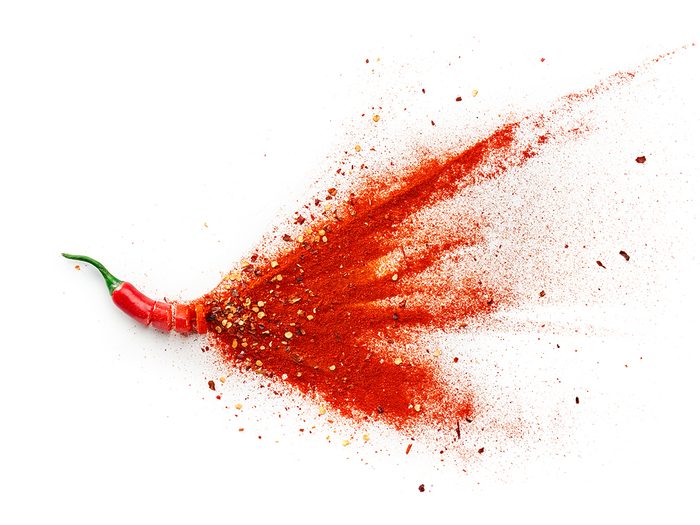
Why We Sweat Over Hot Sauce
For aficionados of spicy food, nothing livens up a dish quite like a splash of hot sauce. Whether a sauce derives its signature heat from jalapeño, cayenne, habanero or chili peppers (or even a blend of several), that numbing, tongue-stinging spice is, for many, a true culinary delight.
These peppers owe their fiery taste to a compound called capsaicin, which—ironically enough—has a primary purpose of deterring mammals (but apparently not foodies) from consuming the plant. The sensation of heat that comes from ingesting capsaicin is generated by receptors in our mouths warning the brain that the substance may be harmful. The brain counters by sending numbing signals to the tongue to ease the discomfort, but sometimes that just isn’t enough to put out the fire.
How to Cool a Burning Mouth
After feeling the burn of a powerful hot sauce, many instinctively try to wash away the heat with a tall glass of cold water. However, it’s been shown that dairy products such as milk and ice cream are much more effective at providing relief, and actually help dissolve the capsaicin molecules on your tongue; the very ones putting your brain in a panic.
Despite the stinging sensation, your favourite spicy dish isn’t damaging your mouth or your taste buds whatsoever. In fact, science has shown that, over time, the more hot sauce and spicy foods you consume, the lesser your body’s reaction to capsaicin.
Spicy foods also have several proven health benefits, including the boosting of your metabolism. It also improves the overall health of your heart by increasing circulation and lowering blood pressure, while also aiding in lowering cholesterol and combating cancer cells. Bon appetit!
Find out more foods that can help lower blood pressure.

How a Hot Sauce’s Heat is Measured
The Scoville Scale, invented in 1972, is a measurement of a chili pepper’s heat and pungency. In general, the higher the concentration of capsaicin within a pepper, the spicier the pepper will be, and the higher it will rank on the Scoville Scale.
To put things into perspective, your typical jalapeño pepper averages between 2,500 to 8,000 Scoville heat units (SHU), while the world’s hottest pepper, the Carolina Reaper, averages 1,569,300 SHU—making it roughly 200 times hotter.
Lucifer’s House of Heat, a hot sauce retailer located in Vancouver, B.C., sells some of the spiciest hot sauces in the world. The Hellfire Kranked Extreme Black Garlic Reaper Sauce is the hottest hot sauce on their shelves, with an SHU of 699,000. As the intimidating name suggests, the sauce’s star ingredient is the Carolina Reaper, described on their website as a pepper with a “rip roaring heat that completely burns your mouth apart.”
Andrew Beteridge, owner of Lucifer’s House of Heat, says the extreme hot sauces on his shelves are usually bought as novelties, and true hot sauce enthusiasts generally go for something more palatable. “Habanero pepper sauces are popular, and are definitely an industry-wide favourite at the moment,” he says. “It’s a milder pepper.”
For novices, Beteridge recommends choosing a sauce nearer the bottom of the Scoville Scale, like the Humble House Ancho & Morita (450 SHU) or the Howler Monkey – Original (600 SHU).
Keep in mind, many hot sauce bottles do not feature any sort of warning labels, recommended servings, or even the hot sauce’s SHU level for that matter, which is why specialty retailers such Lucifer’s House of Heat do their due diligence to inform amateur spice enthusiasts that a little goes a long way, especially as you climb up the Scoville Scale.
Now that you know the hottest hot sauce you can buy, find out what you can tell about maple syrup from its colour.

The All-Nighter
As my brother and I removed the Christmas duck from the oven, my mom headed to my parents’ bedroom to wake my dad up from a nap. It was 11:30 at night.
“What do your friends say when you tell them we do this?” I asked my older brother. He laughed and answered, “They think I’m joking.” I was referring to Noche Buena.
Spanish for “good night,” Noche Buena is the Filipino Christmas Eve feast that begins at midnight and lasts far into Christmas morning. Dating back to when the Philippines became a Spanish colony in the 16th century, Filipinos embraced Noche Buena as a way to celebrate—and eat—after returning home from “Simbang gabi,” or “night mass.” Although my family never attended Christmas Eve masses in Canada, my parents kept the latter part of the tradition when they moved here 30 years ago.
Every Christmas Eve followed the same pattern: the four of us would spend the day rehashing classic, often embarrassing family memories—like my days as a benchwarmer in a youth basketball league—while watching a Home Alone marathon on TV. Unsurprisingly, after a while, it became hard to keep our eyes open.
In order to stay awake, we resorted to playing Christmas songs as loudly as possible. Nevertheless, my brother, mom and I would often catch one another falling asleep in the living room. My dad, meanwhile, would go for a quick snooze as soon as the duck was in the oven at nine o’clock. The rest of us were supposed to keep an eye on the bird.
Half of our feast, including my mom’s embutido, a Filipino-style meatloaf, and fruit salad, had already been made in the afternoon. Other dishes, like the peas, carrots and mashed potatoes my brother and I were responsible for, were whipped up closer to midnight.
We spent the final half-hour before Noche Buena popping in and out of the kitchen, hungry and sleepy, asking one another, “Is it midnight yet?” as if we didn’t know the answer.
But the wait was always worth it.
The roast duck, with its crispy skin and rich, succulent meat, was a hit every time. And while most Canadians were asleep, we were up until four in the morning eating, laughing and looking forward to the new year.
Now that you know the meaning of Noche Buena, check out the best Christmas movies on Netflix this season.
Your phone slips out of your hand and lands in a big rain puddle. You impulsively jump in the pool, forgetting your phone is in your pocket. A bathroom mishap ends with your phone in the toilet.
Feeling panicked yet? It’s no doubt that a phone dropped in water can ruin your day, or even your week. But before you concede to spending a load of cash on a brand-new phone, try one of these solutions that can help dry out your phone, and save you from that all too familiar feeling of dropped-phone dread.
How to Salvage a Soaked Phone
Before attempting a dry-out method for your phone, there are a few things you should always do. After dropping your phone in water, immediately turn it off, remove the phone case, and take out the SIM card. Leave the SIM card tray open so you don’t trap water inside. Wipe down the exterior of your phone with an absorbent cloth to remove any visible water. Once you’ve done these initial steps, try one or more of the following dry-out solutions.
Instead of Putting a Phone in Rice, Use Silica Gel Packets
Despite what you’ve heard, putting your phone in rice might actually do more harm than good. Dust, starch and small grains of uncooked rice can get lodged in the mechanisms of your phone. Instead, use silica gel packets. They are used in packaged and boxed products (such as shoes) to absorb moisture, and can do the same for your phone. Place a few silica gel packets under your phone and on top. Let the phone sit for a few hours while the silica gel packets absorb the water. (Find out 50 more things to repurpose all around the house.)
Air Dry
It may seem like an over-simplified solution, but letting your phone air dry on its own is more effective than you might think. Place your phone on a flat surface, on top of a paper towel, and in a dry, warm space (but not hot, because overheating the phone can cause further damage). You can position a fan to blow on the phone to speed up the drying process. Resist the urge to check if the phone works; let it air dry for at least 24 hours, preferably 48, before turning it on.
Next, find out why you need to stop charging your phone overnight.
Now that your porch has officially been taken over by Amazon Prime boxes, it’s time to transform them into beautifully wrapped gifts to put under the tree. We’re breaking down how to wrap Christmas presents like a pro in just a few simple steps. So turn on your favourite Christmas tunes—Santa’s got a job for you!
To get wrapping, start by gathering all of your supplies. You’ll need your wrapping paper, scissors, tape and any extras like bows, ribbons and gift tags. If you’re wrapping a gift for a child, opt for fun, colourful paper. For a more sophisticated look, rustic brown kraft paper with red string will look beautiful under any tree.
How to Wrap a Gift Box
If you have a variety of shapes to wrap, start with something easy like a gift box. A gift box can hold most items and is perfect for clothes, home items and food gifts.
- Start by rolling out your wrapping paper on a large surface like your kitchen table or island. Place your box in the centre of the paper and measure how much wrapping paper you’ll need. It’s tempting to want to move quickly and just eyeball it, but measuring almost always saves time in the long run.
- Once you’ve cut your square of wrapping paper, pull one side over the gift box and secure it with a piece of tape.
- Gently pull the other side of the wrapping paper over the box and tape it down.
- Next come the sides of the present. With the seam-side up, fold the top of the wrapping paper over the side of the gift box and place a piece of tape.
- Flatten the side into wings and fold them into pointy shapes, one at a time. Pull both sides in over the gift box and secure with tape.
- Finally, pull the bottom side of the wrapping paper up and tape it to the box.
Still need to do some shopping? You’ll find 50 great gift ideas under $50 in our Canadian gift guide.
How to Tie a Ribbon on a Gift
When it comes to bows and ribbons, look for a variety of colours, textures and sizes. Keep proportions in mind, saving the largest bows for the largest gifts. For most food gifts, you can skip the wrapping paper and jump right to the fun decorating part.
To tie a classic ribbon around your gift box, follow these easy instructions.
- Lay the ribbon out straight on your table and place the wrapped present upside down (seam-side up) on top of it. Don’t cut the ribbon just yet, to make sure you have plenty to work with.
- Pull the two sides of the ribbon up and join them with one twist.
- Wrap them over the opposite sides of the present.
- Flip the box over right-side up and tie the two ends of the ribbon into a knot to secure.
- Make a bow, then trim the ribbon to the desired length.
If you’re feeling really crafty, you might want to tackle these DIY holiday decorations, too!
How to Wrap a Gift Without a Box
Gifts without a gift box are a little trickier to wrap. If the gift comes in a beautiful container, a simple bow and gift tag will look festive and elegant.
If your gift still needs to be wrapped, follow the same steps for gift box wrapping or use the tried-and-true gift bag solution. A colourful gift bag with fluffy tissue paper can handle just about any present.
Add DIY Gift Tags
Adding DIY gift tags is the perfect way to top off a thoughtful gift. Tie simple brown gift tags with red and white string around gift boxes, bags or ribbons. If you’re not exactly a DIYer, print off pre-made tags from Etsy or your favourite online shop. Now just sign your name and do your best to wait until Christmas Eve.
Now that you know how to wrap Christmas presents like a pro, check out our collection of all-time favourite Christmas cookie recipes.
“Away in a Manger,” “Silent Night,” “Hark! The Herald Angels Sing…” These names are probably what come to mind when you think about traditional Christmas carols. As classic as these songs are, they’re actually not that old—and definitely not as old as the first Christmas carols.
Christians have been celebrating Christmas since at least 375 A.D. (that’s supposedly when the Church first recognized December 25 as Christmas Day), but “Hark!” came around more than 1,300 years later in 1739. Joseph Mohr wrote the lyrics to “Silent Night” in 1818, and “Away in a Manger” was written even later in 1882. So what did people sing before these classics?
Technically, they sang hymns, not carols. Hymns are more solemn, religious songs, while carols were considered dances accompanied by music, according to NPR. The first of these Christmas hymns was likely “Jesus Refulsit Omnium” (“Jesus, Light of All the Nations”), written by St. Hilary of Poitier in the 4th century.
Another early Christmas hymn is “Corde natus ex Parentis” (“Of the Father’s Love Begotten”). Christian poet Prudentius wrote the Latin poem that inspired this song in the 4th century as well, but it wasn’t set to music until centuries later. You won’t hear either of these early “carols” on the radio, but both are still sung at religious services around Christmas. As far as more familiar Christmas carols, those still don’t appear for centuries. “The Friendly Beasts,” a carol about the animals present at the Nativity, probably originated in France in the 12th century. Fast-forward 500 years, and the world got “Adeste Fideles.” (It was translated in to English as “Oh Come, All Ye Faithful” in 1841.) Just a few years after “Adeste Fideles” came “God Rest Ye Merry Gentlemen,” around 1760.
Now when you hear youngsters call Christmas carols by Bing Crosby and Frank Sinatra “old,” you can smile to yourself. They don’t even know the half of it.
Next, check out our countdown of the best Christmas movies of all time.

The Rewards of Winter Photography
For a number of reasons, some people seem to want to put their photography on hold for the winter. Sure, it’s cold, but you can dress for the weather. It could even be a reason to buy some new winter attire—and the photo ops are simply breathtaking. Wildlife is still around, although you may have to look for it. Most city and provincial parks continue to be home to critters and birds, although some bird species do fly south. The Canada goose is found in considerable numbers, and ring-necked pheasants and California quail also continue to reside in the Okanagan, which is my home. It is also not uncommon to spot great blue heron at local lakes in winter.
Most of us are familiar with the look and feel of the first snowfall; the shapes that we notice as snowflakes build patterns on fences, trees and gates. As a child, you may have become a virtuoso in outlining a masterpiece, sketching with chalk or pastels, adding details and drawing attention to the branches you might not otherwise look at.
This same technique applies to winter photography, in that the mundane takes on a new perspective with each successive snowfall. Wrought iron gates become outlined with snow, and trees that never caught your attention before jump out at you.

Winter Photography Tips
Before you head out, here are a few reminders and suggestions: Think about what you want to photograph before you get outside. Because it’s cold, you’ll want to dress warmly in layers. You might also consider wearing soft cotton liners inside your mittens so that you can feel the controls of your camera but still be comfortable. I know some people who have tried hand warmers. I have also seen winter photography gloves advertised, and once had a pair of gloves with the fingers cut off at the tips.
There are many garments on the market that are breathable and allow perspiration to evaporate while still keeping you dry—Gore-Tex is a good example. A trip to an outdoor-clothing store provides good business for them and good choices for you! Most people know enough not to wear jeans outside in winter and to wear appropriate footwear, but these warrant a mention. Also consider taking ski poles or hiking poles with you, as well as a set of grippers, which can be simple chains or an aggressive cleat.
Whether shooting with a digital camera or using film, you must ensure your camera’s battery is fully charged. It’s common for me to travel with three or four batteries and a charger in my vehicle. Extra batteries can be placed in an inside pocket to keep them warm from body heat. Having a memory card with enough space is important. Gone are the days of two-gigabyte cards. Most people will shoot with a 16- or 32-gigabyte card. If you have a cellphone, you won’t need a memory card, but you will still need to be sure it is fully charged.
The magic of winter is open to anyone who enjoys being outside, whether it is for walking, hiking, snowshoeing, cross-country skiing or fat-tire biking. Don’t think, though, that because you can ride a bike on a dirt trail that it will be easy. My suggestion, based on experience, is to practise before heading out with a camera and your bike.
Check out Canada’s best winter hiking trails.

Photographing Wildlife in Winter
It is also entirely possible to take bird photographs from inside your home, especially if you have set up a feeder. Be aware, though, that if you start feeding the birds, you should keep it up for the entire season, as your feathered friends will rely on you. Over the years, I have had good success with using striped sunflower seeds—to avoid having them show up in my photos, I place the seeds behind snow mounds. California quail, ring-necked pheasants, juncos and chickadees have been my most regular visitors, and northern flickers relish suet feeders. (Don’t miss this guide to the birds of the Okanagan.)
Do not bait areas for predators such as coyotes and other wild animals. You are probably aware of coyotes becoming accustomed to being fed by humans, such as in Vancouver’s Stanley Park. These animals usually meet an unfortunate end.

Special Camera Settings
In addition to birds and mammals, buildings and old machinery—including trucks, wagons and motorcycles—take on unique shapes due to snowfall. These unusual patterns contrasted with the snow allow for opportunities to shoot in black and white (monochrome mode).
Outdoor rinks abound across the country and offer opportunities for fast-action sports photography. If you want to stop the action, remember to shoot with a fast shutter speed. Hockey, curling, ice fishing, biking, cross-country skiing, snowshoeing and downhill skiing are all great outdoor photo opportunities.

Unique Opportunities
Winter is a good time to experiment with your camera and try different techniques. Early in the season, I look forward to frost forming on the glass railing on our sundeck. I’ve tried various coloured backgrounds, with my favourites being black or red. You can reduce glare by controlling the angle of your camera.
My latest obsession is heading to a pond frequented by ducks, Canada geese and great blue heron. Cools Pond is a popular spot in Vernon’s BX region. I am in awe of these birds’ ability to balance as they navigate their takeoffs and landings on the ice.
Crowds are smaller in winter, so over the last two years, my wife and I have found wonderful trails that have been kept free of snow for walking and hiking, contributing to our health, enjoyment and safety. Hats off and a big thank you to the municipalities that look after the walkways and even ensure that washrooms are open and available during winter. Even spending half an hour doing an activity outdoors is enough to be of benefit health-wise, and once you get started, I’d be very surprised if you didn’t stick with it.
Outdoor events offer great photo ops, as well. Last year, the Vernon Winter Carnival parade returned and was a huge crowd-pleaser as a break from the pandemic. It was also an opportunity for the community to show their appreciation to our many first responders. This year, the 63rd edition of the carnival will take place from February 3 to 12. If you’re in the area, come out to enjoy the festivities—and don’t forget your camera!
Next, check out our gorgeous gallery of bird photography.





















